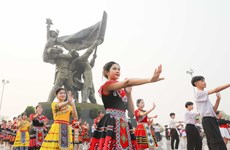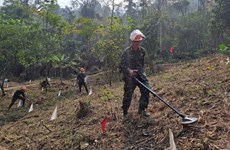Terraced rice fields become National Relics
Terraced rice fields in Hoang Su Phi district, Ha Giang province, has become National Relics.
Terraced rice fields in Hoang Su Phi district, the northeastern province of Ha Giang, become National Relics with a certificate indicating the title handed over to the provincial authorities at a ceremony on September 16.
The magnificent terraced rice fields, which have been cultivated by local ethnic groups for hundreds of years, is the soul of Hoang Su Phi, which is 110km away from Ha Giang’s centre to the west, at the altitude of 1,000m above sea level.
"It is estimated that the terraced rice fields were created around 300 years ago, and have been handed down through generations by the district's 14 ethnic groups," Hoang Hai Ly, chairman of the district's People's Committee, told Vietnam News, the English-language newspaper of the Vietnam News Agency.
"The local terraced fields cover a larger area and are located at a higher altitude than the already recognised (as National Relics) terraced rice fields in Mu Cang Chai (in the northern province of Yen Bai)."
The recognised rice fields cover 760ha of total 3,000ha of fields in six communes: Ban Luoc, San Sa Ho (which belongs to ethnic Dao and Nung groups); Ban Phung (La Chi group); and Ho Thau, Nam Ty and Thong Nguyen (Red Dao group), where the fields stretch into enormous mountains.
The fields also reflect vividly various cultivation methods deployed by different ethnic minority groups inhabited in the place.
Members of the La Chi group, for example, often create terraced fields in areas suitable for building other facilities. For them, the most even surface would be used for building a house, a courtyard, garden, poultry cage and store house. Rice fields are always made above, below or surrounding the house.
The Dao and Nung always choose land near a water source for making rice fields, while the Red Dao choose the most fertile area.
All locals know that to keep water on high mountains they should leave the forests on top of the mountain and make terraced fields only from the middle of mountains or hills.
The Red Dao in Ho Thau commune spare a small area of forest surrounding the terraced fields to avoid land slides.
Locals work from the top of the mountain or hill to the bottom, using simple tools like hoes, wooden rakes, shovels and curved knives.
Making field steps and building dikes on steps to hold water is a difficult task, which requires experience in cultivation.
Steps on the La Chi group's terraced field often measure 20-30cm in width and dikes covering the steps often reach 15-20cm higher than the steps' surface. In the meantime, a step in the Dao and Nung groups' terraced field is as small as an adult's foot.
On steep land and near brooks, locals use rocks to avoid landslides and build dikes for steps by rocks and soil.
In order to use the magnificent terraced rice fields to improve people's lives, local authorities have tested a high-yield rice variety and will distribute it widely to locals if it is effective. Some new vegetables will be introduced this winter crop as well.
Ly said the local tourism department had co-ordinated with neighbouring provinces to create trans-routes linking Bac Ha (Lao Cai); Mu Cang Chai (Yen Bai) and the Dong Van-Meo Vac Karst Plateau (Ha Giang).
The magnificent terraced rice fields, which have been cultivated by local ethnic groups for hundreds of years, is the soul of Hoang Su Phi, which is 110km away from Ha Giang’s centre to the west, at the altitude of 1,000m above sea level.
"It is estimated that the terraced rice fields were created around 300 years ago, and have been handed down through generations by the district's 14 ethnic groups," Hoang Hai Ly, chairman of the district's People's Committee, told Vietnam News, the English-language newspaper of the Vietnam News Agency.
"The local terraced fields cover a larger area and are located at a higher altitude than the already recognised (as National Relics) terraced rice fields in Mu Cang Chai (in the northern province of Yen Bai)."
The recognised rice fields cover 760ha of total 3,000ha of fields in six communes: Ban Luoc, San Sa Ho (which belongs to ethnic Dao and Nung groups); Ban Phung (La Chi group); and Ho Thau, Nam Ty and Thong Nguyen (Red Dao group), where the fields stretch into enormous mountains.
The fields also reflect vividly various cultivation methods deployed by different ethnic minority groups inhabited in the place.
Members of the La Chi group, for example, often create terraced fields in areas suitable for building other facilities. For them, the most even surface would be used for building a house, a courtyard, garden, poultry cage and store house. Rice fields are always made above, below or surrounding the house.
The Dao and Nung always choose land near a water source for making rice fields, while the Red Dao choose the most fertile area.
All locals know that to keep water on high mountains they should leave the forests on top of the mountain and make terraced fields only from the middle of mountains or hills.
The Red Dao in Ho Thau commune spare a small area of forest surrounding the terraced fields to avoid land slides.
Locals work from the top of the mountain or hill to the bottom, using simple tools like hoes, wooden rakes, shovels and curved knives.
Making field steps and building dikes on steps to hold water is a difficult task, which requires experience in cultivation.
Steps on the La Chi group's terraced field often measure 20-30cm in width and dikes covering the steps often reach 15-20cm higher than the steps' surface. In the meantime, a step in the Dao and Nung groups' terraced field is as small as an adult's foot.
On steep land and near brooks, locals use rocks to avoid landslides and build dikes for steps by rocks and soil.
In order to use the magnificent terraced rice fields to improve people's lives, local authorities have tested a high-yield rice variety and will distribute it widely to locals if it is effective. Some new vegetables will be introduced this winter crop as well.
Ly said the local tourism department had co-ordinated with neighbouring provinces to create trans-routes linking Bac Ha (Lao Cai); Mu Cang Chai (Yen Bai) and the Dong Van-Meo Vac Karst Plateau (Ha Giang).
The Dong Van Karst Plateau in the east of the province, covering the districts of Quan Ba, Yen Minh, Dong Van and Meo Vac, was included in the network of global geoparks produced by UNESCO in 2010.-VNA












